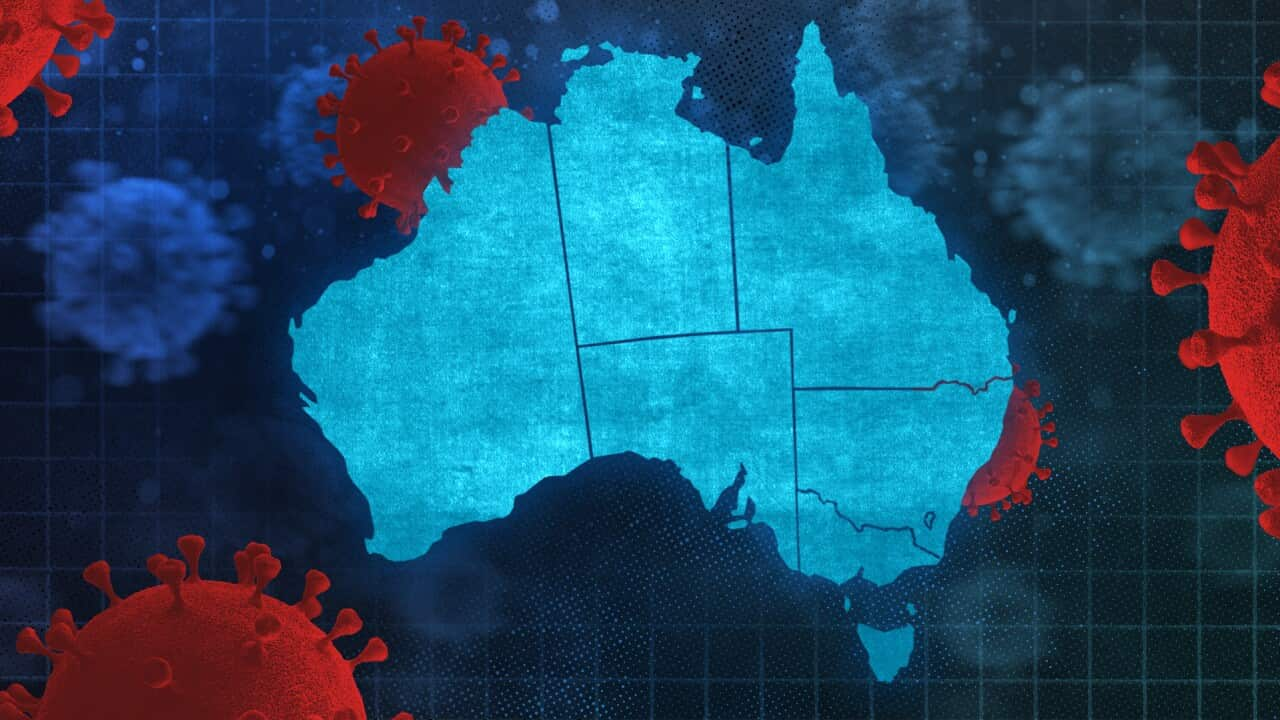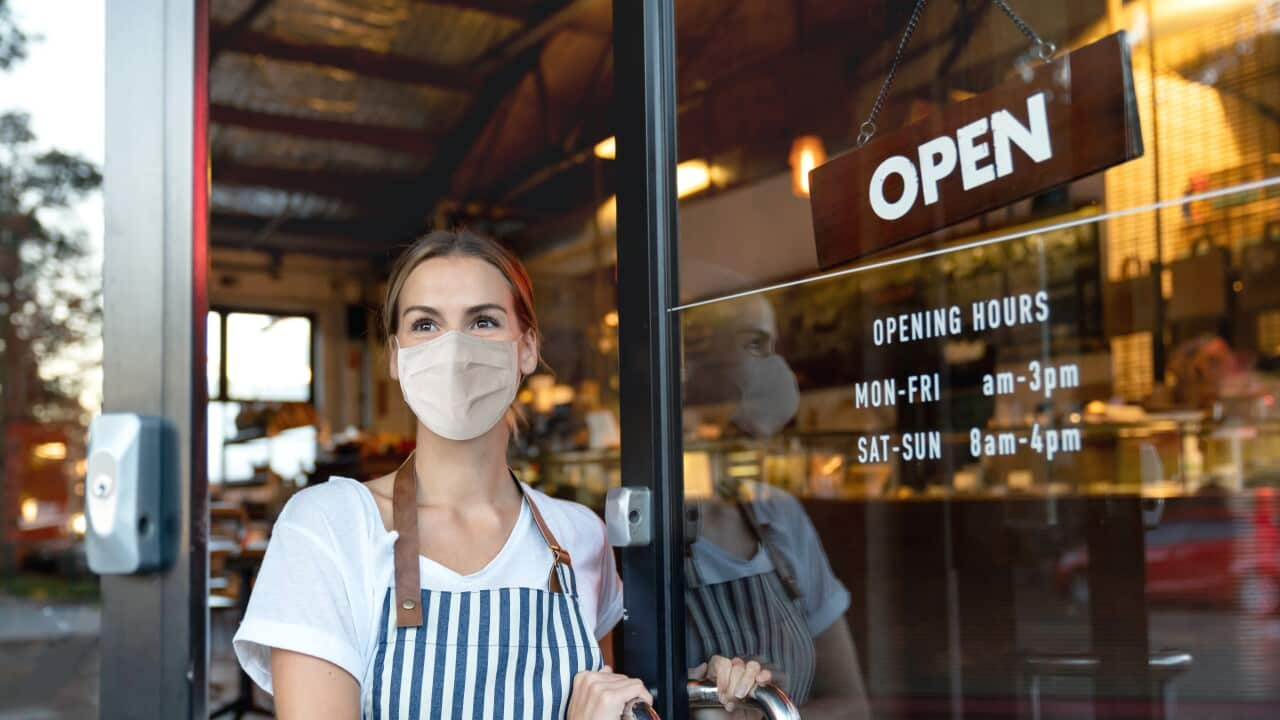

10 min read
This article is more than 2 years old
Australia’s COVID-19 strategy is shifting. Experts are urging against complacency
The future of COVID-19 management in Australia has shifted to a new phase as more rules are relaxed, but the nation should remain on alert, epidemiologists say.
Published 22 April 2022 12:30pm
Updated 22 April 2022 12:34pm
By Biwa Kwan
Source: SBS News / Mar Diaz
Image: Victoria and NSW have taken major restriction-easing steps, but experts are warning against complacency. (SBS News)
Epidemiologists warn that the removal of COVID-19 rules, including the end of hotel quarantine in the most populous Australian states of NSW and Victoria, should sharpen the focus on other measures to combat more dangerous mutations of COVID-19.
They say the measures should include lifting the booster vaccine rate in Australia and contributing more to global vaccine equity initiatives to ensure the first and second dose coverage is increased in poorer nations.
Australia's third dose vaccine coverage is at 69 per cent of the eligible population - a level that epidemiologist Professor Adrian Esterman from the University of South Australia said is "abysmal".
"We're simply not getting enough people getting their booster shot," Professor Esterman said. "It's been hanging around that 65 per cent, 67 per cent level for months now. And really it is the third dose that will protect people, two doses simply isn't sufficient.
"It gives almost no protection against infection. It gives good protection against severe illness and death - but that wanes over time."
"And really, it is that third dose that's going to dampen things down and make sure that our [health] systems aren't swamped."
Announcing the easing in COVID-19 rules on Wednesday, NSW Chief Health Officer Dr Kerry Chant urged people to get their booster shot and their flu shot if eligible, adding officials believe it is the right time to remove a number of COVID-19 measures.
"We are moving into a phase where we want the community to understand better understand risk, better understand how to measure that, and to take prudent and proportionate steps to keep themselves safe," Dr Chant said.
"We want to take a cautious and proportionate approach as we enter those colder months where we know that we might have flu circulating at higher levels, as long as well as COVID."
From 22 April, a, including scrapping close contact isolation requirements and the need to show vaccination status before entering venues.
The and further rules will be relaxed for passengers on flights to Australia. From 30 April, unvaccinated travellers in NSW and Victoria will no longer have to undergo hotel quarantine. Pre-flight testing has already been scrapped for international travellers - and that will be extended to unvaccinated air crew in Victoria.

People take photos as the Pacific Explorer cruise ship enters the Sydney Harbour on 18 April 2022. Source: AAP / AAP
'Transition period'
Epidemiologist Professor Catherine Bennett said Australia is entering a new "transition period" in the COVID-19 pandemic - and that will mean a reconsideration of the policy settings.
"We'll reach a point where we see the waves are no longer the rapid spikes, where we've had a longer period where we haven't seen a brand-new variant of concern that we have to understand and possibly respond to with, with vaccination updates and so on, that will move to a longer-term plan," Professor Bennett said.
"So we're getting there in Australia, we're moving away from rules now to public health advice on the best ways to minimise risk. We have some important rules still in place around our more vulnerable communities and settings.
"But at the end of the day, you know, we are looking forward to a time where this is an additional human pathogen we need to manage and that will take active surveillance."
She said Australia needs to develop more robust surveillance systems to detect the emergence of more powerful COVID-19 variants among international travellers.
"That's one of the important facets of a managed infectious disease - human pathogen - is that you do have a surveillance system in place," she said.
"One that you can make more active at times, if there are alerts from overseas, for example, that new variants; or where they've got data internally, that we're seeing more people in hospital, that's when you then would dial-up and have more active surveillance to get a closer picture - a more immediate picture of what's happening in the wider population.
"So that's part of this transition period. And that's why I don't think we're quite there yet. Because we don't have all the surveillance in place.
"And we don't fully have a handle on what will happen with the virus post the Omicron wave to be able to say that we're set and ready to go."
Changing the 'fully vaccinated' definition
Professor Bennett said options will need to be considered as part of the system, including whether to change the definition of "fully vaccinated" from two COVID-19 doses to three shots for international travellers coming to Australia.
"That might be one option they go to if they do see a problem with people arriving and actually not being able to do the work that came for, or do they travel to Australia but end up in hospital, then we clearly are seeing a pattern where you have to say: well, it's in their interests that we actually tighten up the rules," Professor Bennett said.
Traces of the new Omicron subvariants BA.4 and BA.5 have been , but Professor Bennett said that the latest subvariants are not so different to the parent Omicron variant, and at this stage do not merit a significant change in the current COVID-19 policy.
But that could change if a substantially different COVID-19 virus mutation emerges and is potentially introduced into Australia from overseas arrivals in the country.
"What happens globally, then will impact us, it means we're more or less likely to see a new variant land on our shores that might have come from a country overseas, where there's less controlled infection; or the people that are travelling to our country as visitors or as workers, or as students, their risk changes as we help manage this at a global level," she said.
"So in infectious diseases, you can never just look to your own backyard, you've got to look to the world in order to manage communicable diseases. And that's never been truer than it is with COVID."
Why aren't people getting the third vaccine dose?
While the vaccine uptake for the first and second dose is at more than 95 per cent, the rate is much lower for the third dose at 69 per cent of the eligible population.
At least 215,070 Australians have received four doses - an increase of 52,590 in the week ending 18 April.
The fourth COVID-19 vaccine dose is currently only available to certain people, including vulnerable groups, and those aged over 65.
Associate Professor Holly Seale is an infectious disease social researcher at UNSW and said there is confusion about the urgency of getting a booster shot amid reopening policies, such as the resumption of international travel and return to working in offices.
"The main thing is we need to clearly articulate that out to the community about what is required of them, and also the rationale for why it's required," Associate Professor Seale said.

A healthcare worker administers a COVID-19 vaccination to a patient at a pop-up vaccination van in Epping, Melbourne on 13 October 2021. Source: AAP / AAP
Professor Esterman said the federal and state governments need to do a better job of explaining why the third dose is important.
"It's up to our various governments to do that really good messaging explaining why that third dose is needed, because [there's] a lot of complacency out there," he said.
"I think the key here is that we need to protect our vulnerable people," he said.
Professor Esterman said wearing masks is also a measure that could do much to reduce transmission, but there is a lot of mixed messaging from authorities, despite the .
"[Government officials] say we no longer mandate these things, therefore you've got a responsibility for your own health. The trouble [with that] is that it is not the elderly individuals who aren't wearing masks. You've got an older person who's wearing a face mask goes into a supermarket surrounded by infectious people without masks."
Concerns over 'long COVID'
Australia has recorded more deaths in the first four months of this year - 3,542 - than the combined death toll from 2020 and 2021 of 3,300.
Professor Esterman said with a high number of asymptomatic cases and a fall in the rate of testing, the true case numbers are much higher than official figures suggest.
"So if we're getting 50,000 cases a day that are diagnosed, there will be several times that many being infected every day. So we're getting this enormous number of people who are being affected, recovering. And unfortunately, some of them are dying," he said.
"And the reason why we see such high death numbers is because we've got such high case numbers, we've got an enormous percentage of the population infected, clearly, it's going to have an impact on this, and it has done.
"That's why we're seeing these comparatively high death numbers in the last four months."
More than 5.5 million Australians have been infected with COVID-19 throughout the pandemic.
Professor Estermnn said more information is emerging about long COVID, which underlines the importance of keeping transmission rates down.
"And at the moment, my main concern is long COVID. GPs are already starting to see cases now of people coming in with long-term health problems because of the infection. And that's only going to get worse," he said.
"A . Now health systems have got to deal with that. And we're not we're not placed to do it. So I think for me, that's the biggest concern, and the main reason why we need to at least keep some brake on case numbers."
In the 24-hour reporting period on 21 April, Australia recorded 54,183 new cases - which equates to 9 per cent of the global total of daily infections of 575,667.
Additional reporting by Mar Diaz.




